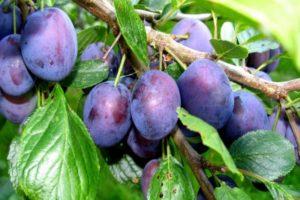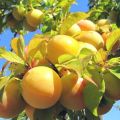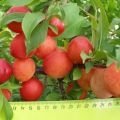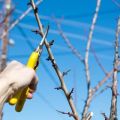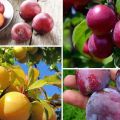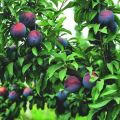Description of the Eurasia plum variety, cultivation and care, pollinators
Eurasia plum is the most unpretentious, early ripe fruitful variety. It belongs to hybrid crops, is popular with amateur gardeners, as it attracts with its unpretentiousness, resistance to climatic conditions. Among the various varieties of plums, Eurasia early ripening is distinguished by its large and sweet fruits.
Plum breeding history Eurasia
Eurasia 21 is a plum variety, bred in the 60s of the last century by domestic breeders, scientists from Voronezh. To obtain a new subspecies, cherry plum was crossed with plum, the varieties Domashnaya, Kitayskaya, American Yellow and East Asian were used. Eurasia has been listed in the State Register of Plums since 1986. The variety can be cultivated in the central regions of the country, in Karelia, Leningrad and Moscow regions.
Description of culture
Eurasia plum is a stone fruit crop with a large spreading crown, it grows to an enormous height - it reaches 5-6 m. In 3-4 years after planting, it turns into a young tree with a lush crown. The thickness of the tree trunk grows very slowly, and the branches grow quickly, for this reason it becomes unstable in windy weather. The crowns are of medium density. Elongated leaves of the tree are pointed, slightly serrated at the edges. Plum flowers are bisexual, self-fertile,
Plum quickly begins to delight with its first sweet fruits in 4-5 years. With proper care, it gives more than 50 kg of yield per tree. Round fruits weighing 20-30 g of deep blue color have sour orange pulp, inside a loose structure. The chemical composition of the fruit is rich in minerals and vitamins.

Specifications
The popularity of the Eurasia 21 variety is due to its excellent taste characteristics and unpretentious care.
Drought and frost resistance
Plum variety Eurasia has good winter hardiness. The stone fruit culture tolerates the conditions of the harsh winter of central Russia well. The root system and flower buds do not die even in twenty-degree and below frosts, since Eurasia is characterized by excellent adaptive properties.
Resistance to ailments and parasites
The plum variety has an average level of resistance to diseases and parasites, therefore, preventive measures must be taken. To prevent the appearance of parasites, it is necessary to attract beneficial insects to the orchard, such as: lacewings, seven-spotted ladybugs, dragonflies. Planted flowering plants give a good result, which exude a smell that repels parasites.
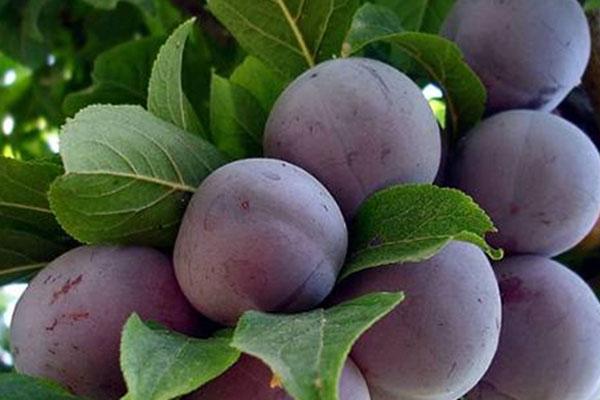
Important! For this, gardeners recommend sowing the aisles with tansy, marigolds, mint, calendula, lemon balm or hyssop.
Pollinator varieties
Plum Eurasia belongs to a self-infertile variety, for this reason, next to the tree, pollinating varieties should be planted in the form of Red Skorospelka, Mayak, Soviet Renklode and Fruitful Renklod, in which the flowering dates for pollination are the same. Eurasia without pollination will not yield a high yield of fruits.
Plum blossom and fruiting
Plum begins to bear fruit 4 years after planting. The harvest in Eurasia 21 is good, but not stable. If in spring in May there were cold days with prolonged rains, then the plant does not bloom well, the fruits are not tied.
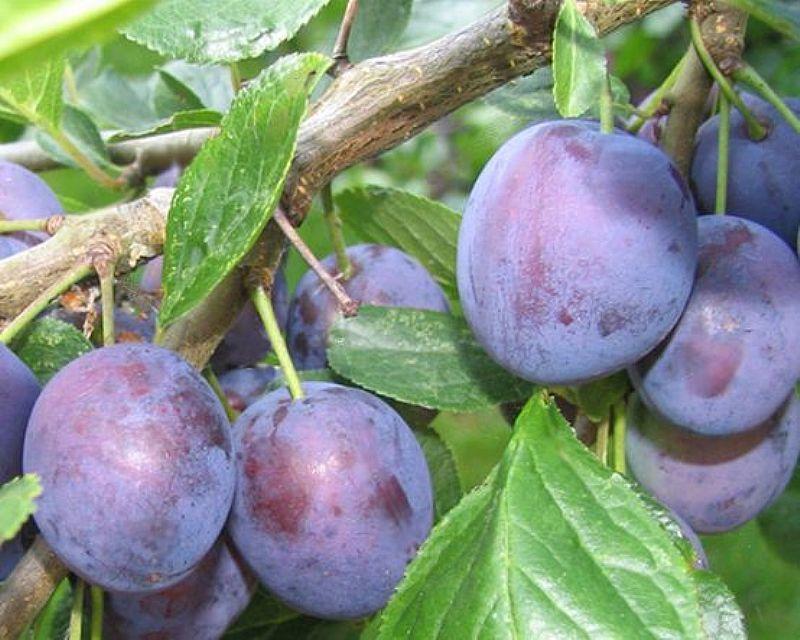
Where is the plum crop used?
The tender fruits of plum contain a lot of tannins, organic acids and vitamins useful for the body. Plum is processed and used for making jam, compotes, pastilles, preserves, marmalades, fresh juicy fruits are used.
Pros and cons of Eurasia plum
Plum Eurasia is popular with many gardeners. They note the advantages of this fruit crop:
- high productivity;
- early maturity, the plant yields a harvest within 3-5 years after planting;
- excellent winter hardiness;
- sweet taste, pleasant aroma;
- keeping quality, fruits retain freshness for a long time.
The plum variety Eurasia also has disadvantages:
- the plum grows to an enormous height;
- the tree should be planted with the appropriate pollinator varieties;
- branches grow quickly, frequent pruning is required;
- fruits are friable;
- the bones are poorly separated;
- the variety cannot be dried for prunes.
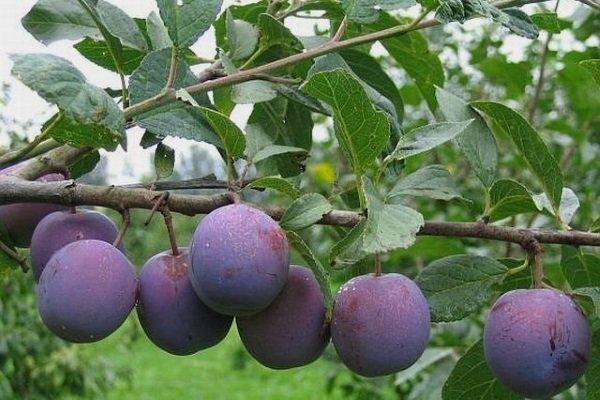
Planting plums on the site
Correct planting at the recommended time and good maintenance will yield a bountiful harvest.
Terms for planting
There are certain dates for planting plums of Eurasia, they are selected taking into account the region. In the central regions and the middle lane, the crop must be planted in the spring, when frost does not threaten to drain. This is usually done in April-May. The tree takes root over the summer in a warm climate and enters the winter stronger.
Autumn planting is more suitable for southern areas: here the winters are not so severe with bitter frosts, the seedlings can winter safely. Between planting a seedling and the onset of stable frosts, about 1.5-2 months should pass. Saplings are planted in dry, calm weather.
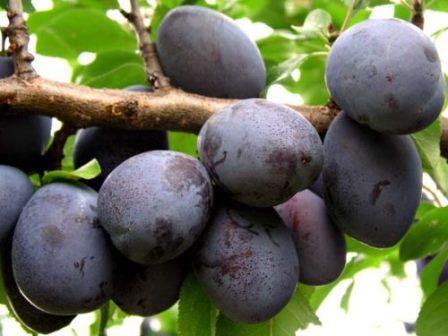
We decide on the place of disembarkation of the plum
For planting plums, you need to choose a well-lit garden spot on the south or southeast side of the site. It should be lit from all directions, especially in the morning. Another requirement for the landing site is a low groundwater table. From the north, tall buildings or fences should protect the tree from the wind.
Plum Eurasia shows good growth on sandy loam or loamy soil.
Important! The culture does not like soil with high acidity, therefore, when planting a tree, it is imperative to lime the soil.
Recommended and contraindicated neighborhood
Birch and poplar, walnut with hazelnuts, fir and pear cannot be neighbors in the garden in Eurasia. Good contact of the plum with the apple tree. You can grow thyme, tulips with daffodils in the aisle. The distance between the plum and the nearest tree should be at least 3-4 m.

On the site where Eurasia is planted, there should be other varieties of home plums that bloom with it at the same time: Record, Yield Renklode, Volzhskaya beauty, Mayak, Memory of Timiryazev.
Seedling preparation
Good healthy material must be selected for planting. To determine quality, one must be guided by the following signs:
- The length of the roots of a quality seedling should be within 10 cm.
- A seedling with a length of 1.5 m and roots up to 30 cm should not have mechanical damage.
- Planting material must be grafted. The site of inoculation is easily determined by the presence of thickening, curvature of the trunk just above the root collar.
- The seedling should have a well-defined conductor with 3-4 lateral shoots 50-70 cm long.
You need to know that 3-year-old seedlings take root worse, so you need to choose 1-2 year old planting material.
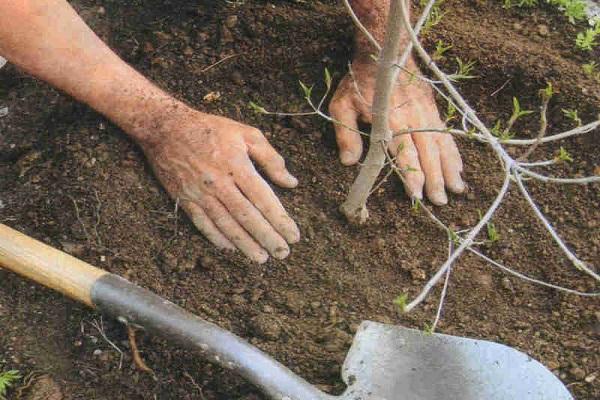
Important! The growth of the culture, its fruiting, largely depends on the quality of the seedling. Planting material must be of high quality, purchased from a nursery or a specialized point of sale of seedlings. When buying, you need to pay attention: the seedlings should have buds slightly increased in size..
Planting technological process
Plum planting Eurasia is carried out in compliance with several stages:
- They dig a hole 90 cm deep, the diameter of which is 2 times the size of the root system of the seedling (usually 70-80 cm).
- The removed soil is mixed with a bucket of peat and humus, superphosphate (500 g), ash. If the soil is acidic, lime by adding 500 g of lime.
- The soil is poured into the hole, a peg is installed in its center, which will be a support for the tree.
- The seedling is placed on a mound, gently spreading the roots, then covered with soil. The tree, slightly lifting it, is shaken to evenly distribute the soil between the roots.
- The root collar is placed at a level of 5 cm above the ground surface, the soil is tamped a little.
- Next, the seedling is tied to a stake, a hole 50 cm wide is made in a circle of the seedling and watered with 20-30 liters of water.
- The near-trunk area is mulched with wood chips or peat in a layer of 10 cm.

Plant care
Plum care Eurasia 21 consists of timely watering, loosening the soil, weeding row spacings, pruning and top dressing. It must be protected from rodents and reliably prepared for wintering.
Regularity of watering
Plum Eurasia is distinguished by its exactingness to frequent watering. Lack of moisture can lead to the fall of flower ovaries and to the loss of part of the crop. The irrigation regime is determined by the amount of precipitation and weather conditions of the area. Watered with water directly under the root of a fruiting tree. After planting a tree, it must be watered after 8-10 days, pouring at least 3 buckets of settled water under the root.
A mature, rooted tree should be watered 2 times a month. At the same time, it is recommended to pour from 60 to 100 liters of water under the root of each culture. After watering, the near-trunk soil must be fluffed and mulched. It is necessary to ensure that the irrigation water saturates the soil by about half a meter. To increase winter hardiness, in the fall it is necessary to water the plums.
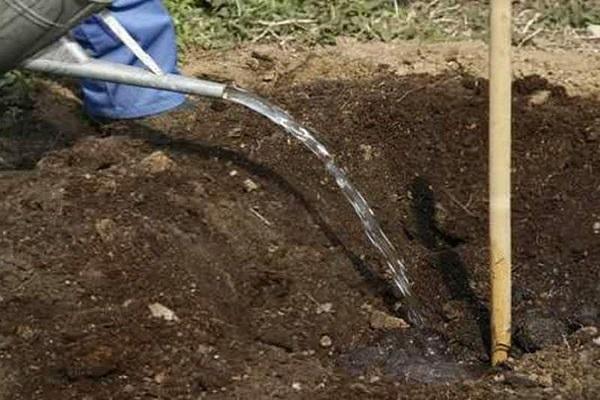
Important! With a lack of moisture, the plum fruits will crack and lose their presentation, and with an overabundance, the leaves will turn yellow.
What and how to feed the Eurasia plum variety
Plum is characterized by responsiveness to fertilizing with conventional fertilizers, which contain nitrogen, phosphorus and potassium and magnesium. The plant is fed by introducing fertilizers into the soil of the near-trunk circle, while simultaneously loosening it. Introduce 10 to 12 kg of organic matter with nitrogen into the soil per 1 square meter of area once every 3-4 years in the spring.
Constant seasonal feeding is done in this way:
- Before flowering, fertilize with ammonium nitrate (1 tablespoon per 10 liters).
- During the flowering period, 2 tablespoons of potassium sulfate with urea per 10 liters.
- During the fruit set, 3 tbsp. nitroammofoski 10 l
- After harvesting, add 3 tbsp.superphosphate into the soil when digging.
Advice! In summer, it is useful to feed using infusion of mullein or chicken droppings.
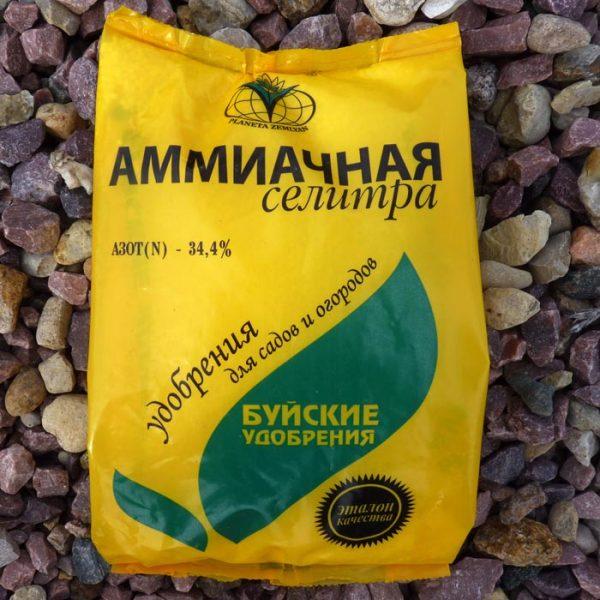
Young plum pruning and crown formation
The first pruning of plums is done to form the crown and create a skeleton in mid-autumn. The crown is formed from 5-7 well-developed, well-placed skeletal branches. In this case, the third part of the trunk is left to ensure the normal growth of young branches. In addition, the remaining shoots are shortened by 1/3 of their length.
When forming the crown, it is worth paying attention to the fact that the distance between the branches should be within 20-30 cm. In the summer, pruning of the main trunk is not practiced, only the lateral branches are shortened by 20-30 cm.
In the fall, they are engaged in pruning young lateral shoots, and also remove dry and diseased branches. In grafted mature trees, root shoots should be removed in summer to the root base of the parent plant. When the plum enters the fruiting season, a conductor is cut over the highest and most developed branch. Thus, a bowl-shaped crown is formed, which is shone from all sides by the rays of the sun.
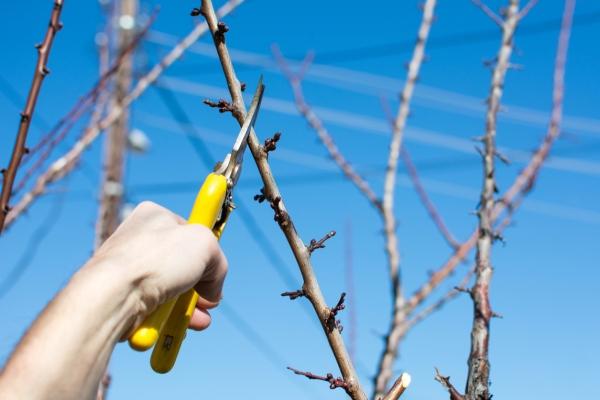
Important! After each pruning, the cuts are necessarily processed with garden varnish or varnish-based paint.
Barrel circle care
Proper care of the near-stem circle of the plum is of great importance in the development of the plant. In the summer, weeding should be done, freeing the land from weeds. In autumn, it is imperative to dig around the tree and in the aisle 15 cm deep. In time it is necessary to collect fallen leaves and burn. Rotten carrion should not be left on the ground, such fruits can be a source of disease, so you also need to get rid of them.
Preventive measures and getting rid of pests
Plum is susceptible to disease and attack from pests. Plum aphid damages the leaves, this leads to a delay in the growth of shoots, a decrease in the amount of plum harvest and the winter hardiness of the tree. To protect the plum from aphids, it is necessary to spray the plant during flowering with a 3% carbamide solution.
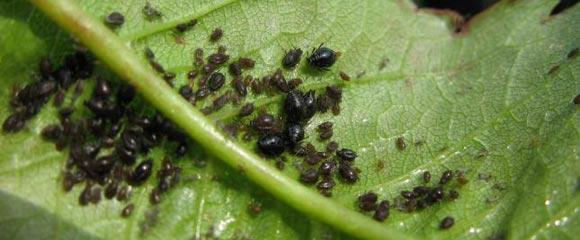
The larvae of the plum sawfly damage the fruits of the plum, sometimes they can destroy the entire crop. From the larvae, the tree is processed after flowering using Bordeaux liquid, karbofos. Caterpillars of the moth eat the kernels near the plum. The fruits stop growing, then fall off. One caterpillar can damage the crops of several trees. It is necessary to escape from the moth in the summer with trapping belts.
Preventive measures against the moth are:
- Land cultivation by autumn digging;
- Weeding in the summer and loosening the soil;
- Pruning branches to avoid thickening.
Fruit rot results in a brown spot. Plum pulp becomes tasteless, watery. Phytosporin is used for treatment before flowering.
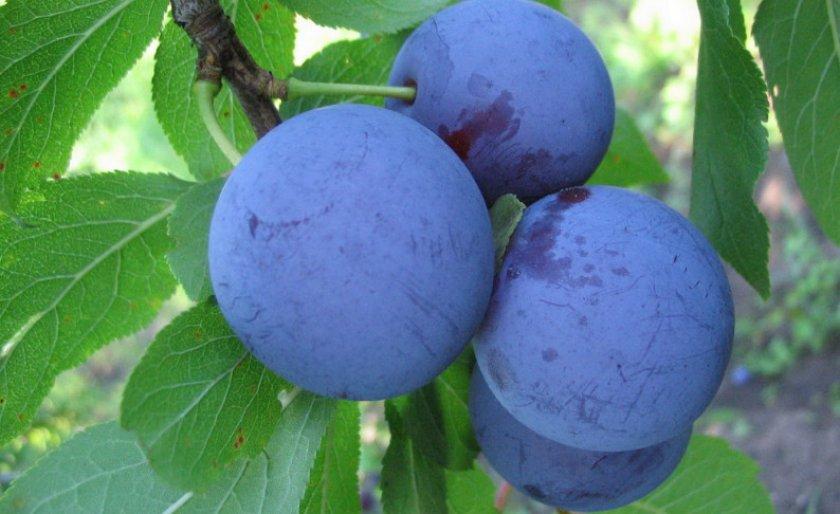
Preparing the tree for winter
Despite its excellent winter hardiness, the plum tree requires preparation for the cold winter. First, you need to remove fallen dry leaves, then do moisture-charging irrigation. Then you need to dig up the ground around the tree and mulch the soil with sawdust. Mandatory treatment of the plum trunk with garden whitewashing. To prepare the solution, you need to take 3 kg of lime, 400 g of copper sulfate, 50 g of casein glue and mix everything in 10 liters of water. Before whitewashing, it is necessary to clean the tree trunks from dry bark and moss.
In young plants, branches are tied to the trunk and insulated with a material that allows air to pass through. The trunk must be insulated using spruce branches or a polymer net, this will serve as a good protection from any rodents in winter. A rag is laid out next to the tree, moistened with mint oil or turpentine, the pungent smell of which will scare away mice.
In general, the Eurasia variety is in demand among gardeners, since it is distinguished by its unpretentiousness, frost resistance, and pleases with an early bountiful harvest.

